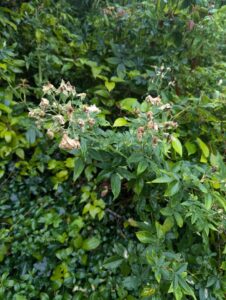
“I love your wildflowers,” said the contractor last week, looking over my garden. He was thinking, “this place looks completely wild.”
“Thank you,” I said, taking in the same scene. I was thinking with chagrin, “this garden is in the middle of the midsummer uglies.”
The problem, of course, is the asters. My front garden, and to a somewhat lesser extent, my back garden, are full of tall New England asters or, in tongue-twisting botanical Latin, Symphyotrichum novae-angliae. The asters are awaiting their moment of glory, which should come in a few weeks, but right now they look like gangly, somewhat branched stems that top out at about three feet. In short, my garden beds look like fields of weeds.
Of course, the real weeds are growing at the feet of the asters, momentarily camouflaged by the tall stalks. The weeds will come roaring back at the end of the asters’ bloom period, but that is a story for another day.
Most of my asters are descendents of a single specimen of ‘Andenken an Alma Potschke’—‘Alma Potschke’ for short—that I planted years ago. ‘Alma’ is a rampant self-seeder, which has worked to my benefit. The original plant bore dark pink daisy-like flowers. The masses of offspring bloom in that color, as well as in paler and darker shades, making for a beautiful garden tableau.
But of all of that is in the future. Right now the garden is in the throes of the uglies. Most of us without a ready supply of cash to pay garden minions, have an ugly corner or two. The problems with having a plethora of ‘Alma Potschke’ is that two thirds of my yard has become an ugly corner.
As with most things inside and outside the garden, it could be worse. My ‘Alma Potschke’ plants could be six feet tall and weedy, instead of three feet tall. I have been cutting them back regularly since they first sprouted to keep the growth under control and encourage the branching that results in more flowers. Some years I am helped in the task by the local deer herd who like to nibble on the tips. This year Mr. Antlers and his brigade have focused on the hostas and largely left the asters alone.
So I have clipped and clipped and clipped, resulting in a much more manageable field of weedy vegetation.
The picture is not completely bleak. Here and there clumps of coneflowers pop up like jewels. A few of the roses are making an effort, despite the intense summer heat. Some Stokes asters or stokesia are displaying blue blossoms, and the blue perennial ageratums are just beginning to open into misty clouds of petals. Some of the hydrangeas—oakleaf and bigleaf types—have resisted the general trend of turning from blue or pink to a tired shade of beige.
Every year when this happens, someone—a dog walker or neighbor—mentions how much they love the garden while looking askance at the asters-in-waiting. I generally smile nicely and attempt to feel secure in the knowledge that they will be glorious in a few weeks. However sometimes the dark side takes over and I think about removing at least some of the asters in favor of something like dahlias that dazzle at this time of year. Barring dahlias, which are expensive but effective, I think about increasing the supply of colorful annuals to fill the holes one taken by the asters that I plan to pull out.
But annuals take a lot of water and plant food in the dog days of summer, while asters maintain their pristine ugliness with absolutely no help.
The asters clearly have more fortitude than the gardener.
Fortunately my lack of fortitude has forced me to retreat inside to the coolness of my house to contemplate next steps. As in years past, my next step is to do nothing. If the shame of my weedy-looking spread gets to be too much, I’ll just do my gardening in the back yard until the asters burst into bloom. When that finally happens, I’ll go out in the front yard once more and bask in the adulation of those neighbors and dog walkers. I will forget the uglies until next year.
